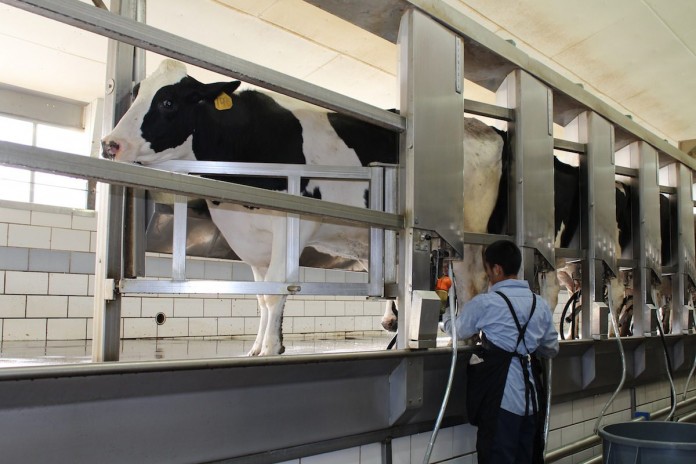CORVALLIS, Ore. — Cows raised on organic and conventional dairy farms in three regions of the United States show no significant differences in health or in the nutritional content of their milk, according to a new study by Oregon State University researchers and their collaborators.
Many organic and conventional dairies in the study also did not meet standards set by three commonly used cattle welfare programs.
“While there are differences in how cows are treated on organic farms, health outcomes are similar to conventional dairies,” said Mike Gamroth, co-author of the study and professor emeritus in OSU’s College of Agricultural Sciences. “Few dairies in this study performed well in formal criteria used to measure the health and well-being of cows.”
Nearly 300 small dairy farms — 192 organic and 100 conventional — in New York, Oregon and Wisconsin, participated in the study, which was funded by a $1 million grant from the National Institute of Food and Agriculture in the U.S. Department of Agriculture.
Many aspects
The five-year project looked at many aspects of dairy cow health, including nutrition, lameness, udder cleanliness, and other conditions. Milk samples were screened for bacteria and common diseases, and farmers were asked about their operations, including the use of veterinarians and pain relief when removing horns from cattle.
Researchers found the following: One in five herds met standards for hygiene, a measure of animal cleanliness; 30 percent of herds met criteria for body condition, which measures size and weight of cows; and only 26 percent of organic and 18 percent of conventional farms met recommendations for pain relief during dehorning.
Four percent of farms fed calves recommended doses of colostrum, which helps boost their limited immune systems after birth; 88 percent of farms did not have an integrated plan to control mastitis, a common disease in dairy cattle; 42 percent of conventional farms met standards for treating lameness; cows on organic farms produced 43 percent less milk per day than conventional non-grazing cattle, the study found, and 25 percent less than conventional grazing herds.
Few differences
Milk from organic and non-organic herds also showed few nutritional differences, researchers found. Organic milk can occasionally contain more omega-3 fatty acids, which may improve heart health. However, those increases come from seasonal grazing and are not present when cattle are fed stored forage, according to Gamroth.
To become USDA-certified, organic dairy farms must allow cows access to grazing, and the grain cows consume must be grown on land free of pesticides and fertilizers. Organic farmers are not allowed the use of antibiotics, hormones or synthetic reproductive drugs.
“Nearly seven in 10 organic farms previously operated conventional herds, which explains the lack of differences between them,” said Gamroth. “Many organic farmers operate in a similar fashion to when they raised conventional herds, from milking procedures, to using the same facilities, to caring for sick cattle.”
More veterinarians
The study also found more conventional farms (69 percent) used veterinarians than organic dairies (36 percent). Organic dairy farmers often perform their own veterinary work, Gamroth said, because they feel vets do not always know or follow organic standards for care.
Some organic herds in the study also showed a strain of bacteria, commonly known as Strep. ag., that conventional herds eliminated long ago, by using antibiotics.
Organic farms did perform better in some areas of health: Cows had fewer hock lesions — injuries to the legs that often form from being housed for long periods. Calves on organic farms were also fed a greater volume of milk and were weaned at an older age than on conventional farms.
Results were based on criteria from three commonly used cattle welfare programs: the American Humane Association’s Animal Welfare Standards for Dairy Cattle, Farmers Assuring Responsible Management, and the Canadian Codes of Practice.
However, the dairies surveyed for the study were not committed to these standards, said Gamroth.
“Our data shows there is room for improvement in dairies and sets a benchmark to measure progress in the industry,” Gamroth said. “We believe adopting animal welfare standards is part of the solution, as are increases to educational efforts to improve the care of cows.”











ummm…what about what is “in” the conventional milk that nobody wants their kids to drink (i.e., antibiotics, hormones or synthetic reproductive drugs)?
Milk is strictly screened for antibiotics and the farmer is severely penalized for failing to comply after the milk is dumped down the drain. They won’t report on differences in hormone levels because no one has ever measured a difference between conventional and organic. All milk has hormones in it. Even soy has plant derived hormones. There is one difference. The overall carbon footprint. Much bigger in organic herds.
That’s a simple answer. It isn’t in the milk. As soon as a cow is treated with something, her milk is not put into the tank with the healthy cows, instead it is disposed of, until she is healthy and the drugs she was given have passed through her system. Its no different than you getting sick and getting an antibiotic or another medicine.
This might be of interest to Keith. I know I read somewhere that there’s really no difference between rBST milk and non rBST milk. https://www.globaldairyinnovation.com/dairy-milk-production/rbst-treated-cows.aspx
If it’s of criticial interest, I’m sure he can find some primary sources to confirm that.
All cow’s milk is unhealthy for humans because, quite simply, it is food intended for a calf. The natural growth hormones and other components of milk are present in quantities much greater than those found in human breast milk, the appropriate milk for human youngsters. Adults really shouldn’t be drinking milk at all after they’re weaned as infants. Many cannot even digest it property, which is as nature intends. The largest land mammals on earth manage bone development and health just fine without ingesting the milk of another species. Humans would do well to follow suit (with great benefits to human health and the environment).